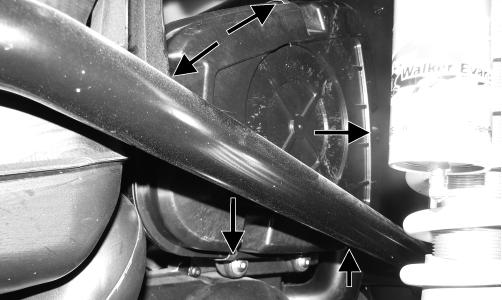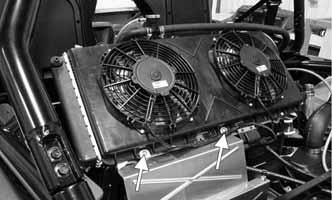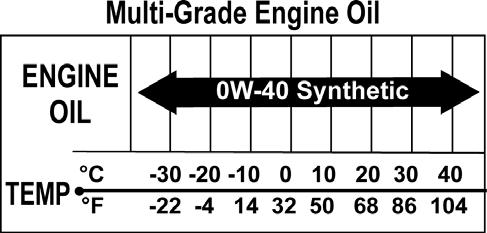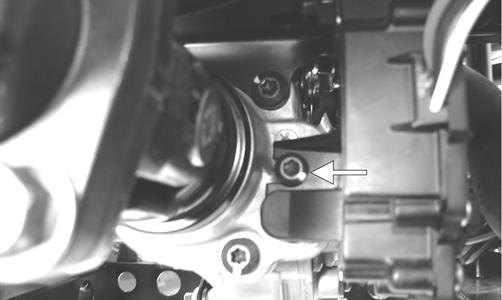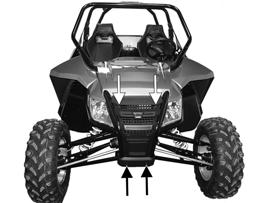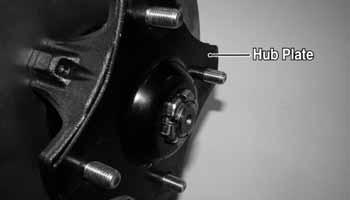
43 minute read
Electrical System
NOTE: Certain components and sensors can be
checked by using the EFI diagnostic system and digital gauge (see EFI Diagnostic System in this section for more information).
The electrical connections should be checked periodically for proper function. In case of an electrical failure, check fuses, connections (for tightness, corrosion, damage), and/ or bulbs. SPECIAL TOOLS A number of special tools must be available to the technician when performing service procedures in this section. Refer to the current Special Tools Catalog for the appropriate tool description.
Description p/n
Fluke Model 77 Multimeter 0644-559 Timing Light MaxiClips Test Plug/Error Code List 0644-296 0744-041 0444-216
NOTE: Special tools are available from the Arctic
Cat Service Department.
Battery
NOTE: Preliminary checks may be performed on
this component using the diagnostic mode on the LCD gauge (see EFI Diagnostic System in this section)
The battery is located in a compartment at the rear of the center console. NOTE: To access the battery box, the battery cover
must be removed.
After being in service, batteries require regular cleaning and recharging in order to deliver peak performance and maximum service life. The following procedures are recommended for cleaning and maintaining sealed batteries. Always read and follow instructions provided with battery chargers and battery products. NOTE: Refer to all warnings and cautions provided
with the battery or battery maintainer/charger.
Loss of battery charge may be caused by ambient temperature, ignition OFF current draw, corroded terminals, self discharge, frequent start/stops, and short engine run times. Frequent winch usage, snowplowing, extended low RPM operation, short trips, and high amperage accessory usage are also reasons for battery discharge.
NOTE: Arctic Cat recommends the use of the CTEK
Multi US 800 or the CTEK Multi US 3300 for battery maintenance charging. Maintenance charging is required on all batteries not used for more than two weeks or as required by battery drain.
800E
1.When charging a battery in the vehicle, be sure the ignition switch is in the OFF position. 2.Clean the battery terminals with a solution of baking soda and water. NOTE: The sealing strip should NOT be removed
and NO fluid should be added.
3.Be sure the charger and battery are in a well-ventilated area. Be sure the charger is unplugged from the 110-volt electrical outlet. 4.Connect the red terminal lead from the charger to the positive terminal of the battery; then connect the black terminal lead of the charger to the negative terminal of the battery. NOTE: Optional battery charging adapters are avail-
able from your authorized Arctic Cat dealer to connect directly to your vehicle from the recommended chargers to simplify the maintenance charging process. Check with your authorized Arctic Cat dealer for proper installation of these charging adapter connectors.
5.Plug the battery charger into a 110-volt electrical outlet. 6.If using the CTEK Multi US 800, there are no further buttons to push. If using the CTEK Multi US 3300, press the Mode button (A) at the left of the charger until the Maintenance Charge Icon (B) at the bottom illuminates. The Normal Charge Indicator (C) should illuminate on the upper portion of the battery charger. NOTE: The maintainer/charger will charge the bat-
tery to 95% capacity at which time the Maintenance Charge Indicator (D) will illuminate and the maintainer/charger will change to pulse/float maintenance. If the battery falls below 12.9 DC volts, the charger will automatically start again at the first step of the charge sequence.
3300A
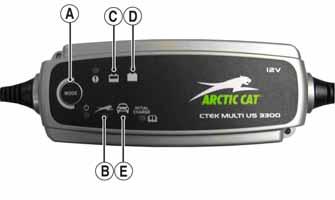
NOTE: Not using a battery charger with the proper
float maintenance will damage the battery if connected over extended periods.
Charging
NOTE: Arctic Cat recommends the use of the CTEK
Multi US 800 or the CTEK Multi US 3300 for battery maintenance charging.
1.Be sure the battery and terminals have been cleaned with a baking soda and water solution. NOTE: The sealing strip should NOT be removed
and NO fluid should be added.
2.Be sure the charger and battery are in a well-ventilated area. Be sure the charger is unplugged from the 110-volt electrical outlet. 3.Connect the red terminal lead from the charger to the positive terminal of the battery; then connect the black terminal lead of the charger to the negative terminal of the battery. 4.Plug the charger into a 110-volt electrical outlet. 5.By pushing the Mode button (A) on the left side of the charger, select the Normal Charge Icon (E). The
Normal Charge Indicator (C) should illuminate on the upper left portion of the charger. 6.The battery will charge to 95% of its capacity at which time the Maintenance Charge Indicator (D) will illuminate. NOTE: For optimal charge and performance, leave
the charger connected to the battery for a minimum 1 hour after the Maintenance Charge Indicator (D) illuminates. If the battery becomes hot to the touch, stop charging. Resume after it has cooled.
7.Once the battery has reached full charge, unplug the charger from the 110-volt electrical outlet.
RPM Limiter
NOTE: The Wildcat is equipped with an ECM that
interrupts the ignition when maximum RPM is approached. When the RPM limiter is activated, it could be misinterpreted as a high-speed misfire.
Testing Electrical Components
All of the electrical tests should be made using the Fluke Model 77 Multimeter. If any other type of meter is used, readings may vary due to internal circuitry. When troubleshooting a specific component, always verify first the fuse(s) are good, the LED(s) are good, the connections are clean and tight, the battery is fully charged, and all appropriate switches are activated. NOTE: For absolute accuracy, all tests should be
made at room temperature of 68° F.
Accessory Receptacle/ Connector
NOTE: This test procedure is for either the recepta-
cles or the connectors.
VOLTAGE 1.Turn the ignition switch to the ON position; then set the meter selector to the DC Voltage position. 2.Connect the red tester lead to the positive connector; then connect the black tester lead to the negative connector. 3.The meter must show battery voltage. NOTE: If the meter shows no battery voltage, trou-
bleshoot the fuse, receptacle, connector, or the main wiring harness.
Brakelight Switch
The switch connectors are spade-type connectors on the side of the master cylinder. NOTE: The ignition switch must be in the ON posi-
tion.
VOLTAGE (Wiring Harness Connector) 1.Set the meter selector to the DC Voltage position. 2.Connect the red tester lead to the orange wire; then connect the black tester lead to the red wire.
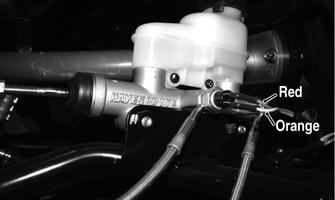
WC002B
3.The meter must show battery voltage. NOTE: If the meter shows no battery voltage, trou-
bleshoot the fuse, switch, or the main wiring harness.
NOTE: If the meter shows battery voltage, the main
wiring harness is good; proceed to test the switch/ component and the connector.
RESISTANCE (Switch Connector) NOTE: The brake pedal must be depressed for this test.
1.Set the meter selector to the OHMS position. 2.Connect the red tester lead to one terminal; then connect the black tester lead to the other terminal. 3.When the pedal is depressed, the meter must show less than 1 ohm. NOTE: If the meter shows more than 1 ohm of resis-
tance, replace the switch.
Engine Coolant Temperature (ECT) Sensor
NOTE: Preliminary checks may be performed on this
component using the diagnostic mode on the LCD gauge (see EFI Diagnostic System in this section).
1.Connect the meter leads (selector in OHMS position) to the sensor terminals. 2.Suspend the sensor and a thermometer in a container of cooking oil; then heat the oil. NOTE: Neither the sensor nor the thermometer
should be allowed to touch the bottom of the container or inaccurate readings will occur. Use wire holders to suspend the sensor and thermometer.
! WARNING
Wear insulated gloves and safety glasses. Heated oil can cause severe burns.
3.On the ECT sensor when the temperature reaches 40°
C (104° F), the meter should read approximately 1136 ohms. 4.On the ECT sensor when the temperature reaches 100° C (212° F), the meter should read approximately 155 ohms. 5.If the readings are not as indicated, the sensor must be replaced. 6.Install the sensor and tighten securely. 7.Connect the leads.
Fan Motor
NOTE: Preliminary checks may be performed on
this component using the diagnostic mode on the LCD gauge (see EFI Diagnostic System in this section).
RESISTANCE (Fan Motor Connector) 1.Set the meter selector to the OHMS position. 2.Connect the red tester lead to one motor lead; then connect the black tester lead to the other motor lead.
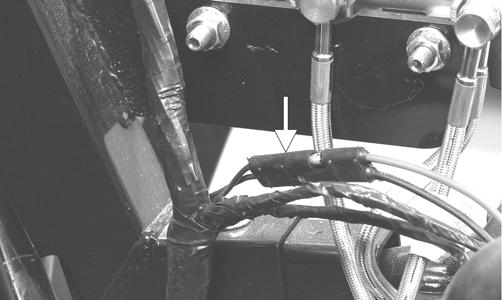
PR183A
3.The meter must show less than 1 ohm. NOTE: If the meter shows more than 1 ohm of resis-
tance, troubleshoot or replace the fan motor.
NOTE: To determine if the fan motor is good, con-
nect the red wire from the fan connector to a 12 volt battery; then connect the black wire from the fan connector to ground. The fan should operate.
! WARNING
Care should be taken to keep clear of the fan blades.
Power Distribution Module (PDM)
FUSES/RELAYS NOTE: To access fuses and relays, compress the
locking tabs on either side of the PDM cover and lift off.
The fuses are located in a power distribution module under the passenger’s seat. If there is any type of electrical system failure, always check the fuses first. The 4-pin relays are identical plug-in type located on the power distribution module. Relay function can be checked by switching relay positions. The 4-pin relays are interchangeable. NOTE: The module and wiring harness are not a service-
able component and must be replaced as an assembly.
1.Remove a fuse from the power distribution module. 2.Set the meter selector to the DC Voltage position. 3.Connect the black tester lead to ground. 4.Using the red tester lead, contact each end of the fuse holder connector terminals individually. 5.The meter must show battery voltage from one side of the connector terminal ends. NOTE: Battery voltage will be indicated from only
one side of the fuse holder connector terminal; the other side will show no voltage.
NOTE: When testing the HI fuse holder, the headlight OFF/HI/LO switch must be in the HI position; when testing the LIGHTS fuse holder, the headlight dimmer switch can be in either the HI or LO position.
NOTE: If the meter shows no battery voltage, trou-
bleshoot the battery, switches, power distribution module, or the main wiring harness.
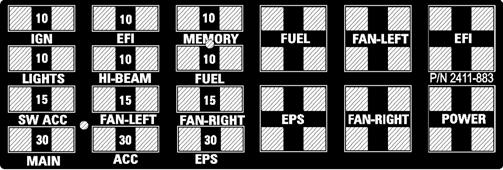
2411-883
This vehicle uses automotive-style (see-through) fuses. The fuses can be visually inspected; replace fuse if link is open.
CAUTION
Always replace a blown fuse with a fuse of the same type and rating.
NOTE: Make sure the fuses are returned to their proper
position according to amperage. Refer to the amperage listed under each fuse on the power distribution module.
Ignition Coil
The ignition coils are mounted to the lower radiator frame (rear cylinder) and the forward heat shield (front cylinder). Remove the rear body panel and cargo box to access the coils. VOLTAGE (Primary Coil) 1.Set the meter selector to the DC Voltage position; then disconnect the connector from the coil to be tested.
2.Connect the red tester lead to the orange wire and the black tester lead to ground. 3.Turn the ignition switch to the ON position. The meter must show battery voltage. RESISTANCE
CAUTION
Always disconnect the battery when performing resistance tests to avoid damaging the multimeter.
NOTE: For these tests, the meter selector should be
set to the OHMS position.
Primary Winding 1.Disconnect the primary connector and connect the red tester lead to one terminal; then connect the black tester lead to the other terminal. 2.The meter reading must be within specification. Secondary Winding 1.Connect the red tester lead to the high tension lead (with the plug cap removed); then connect the black tester lead to either primary terminal. 2.The meter reading must be within specification. NOTE: If the meter does not show as specified,
replace ignition coil.
Spark Plug Cap 1.Connect the red tester lead to one end of the cap; then connect the black tester lead to the other end of the cap.
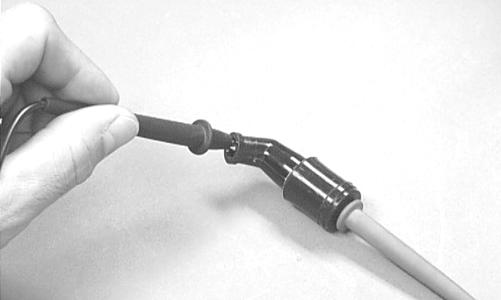
AR603D
2.The meter reading must be within specification. NOTE: If the meter does not show as specified,
replace the spark plug cap.
Manifold Absolute Pressure/Inlet Air Temperature (MAP/IAT) Sensor
NOTE: Preliminary checks may be performed on this
component using the diagnostic mode on the LCD gauge (see EFI Diagnostic System in this section).
1.Disconnect the MAP/IAT connector from the sensor located on top of the throttle body. 2.Select DC Voltage on the tester and turn the ignition switch to the ON position. 3.Connect the black tester lead to the gray/white wire and the red tester lead to the green/black wire. The meter should read 4.5-5.5 DC volts. If the meter does not read as specified, check the ECM connector or wiring. 4.Connect the MAP/IAT to the harness; then using Maxi-
Clips, connect the red tester lead to the pink/black wire and the black tester lead to the gray/white wire. With the engine running at idle speed, the meter should read approximately 2.5 DC volts (MAP sensor signal). 5.Connect the red tester lead to the green/black wire.
With the engine at idle and at room temperature (approximately 60° F), the meter should read approximately 2.9 DC volts. NOTE: If the meter does not read as specified,
replace the sensor.
Speed Sensor
NOTE: Preliminary checks may be performed on this
component using the diagnostic mode on the LCD gauge (see EFI Diagnostic System in this section).
NOTE: Prior to testing the speed sensor, inspect the
three-wire connector on the speed sensor for contamination, broken pins, and/or corrosion.
1.Set the meter selector to the DC Voltage position. 2.With appropriate needle adapters on the meter leads, connect the red tester lead to the voltage lead (V); then connect the black tester lead to the ground lead (G).
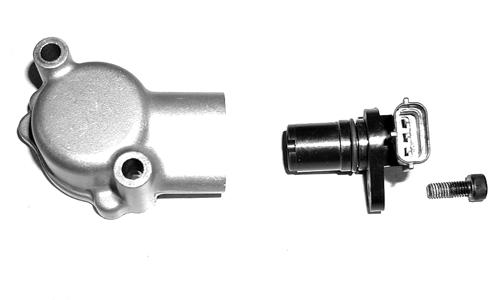
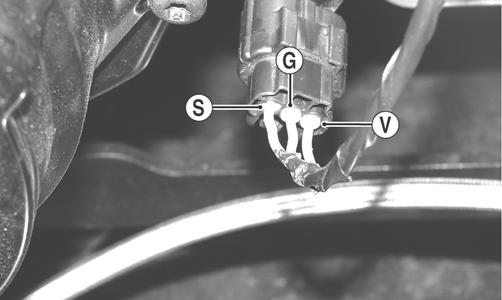
PR279A
3.Turn the ignition switch to the ON position. 4.The meter must show approximately 6 DC volts. 5.Leave the black tester lead connected; then connect the red tester lead to the signal lead pin (S). 6.Slowly move the vehicle forward or backward; the meter must show 0 and approximately 6 DC volts alternately.
NOTE: If the sensor tests are within specifications,
the LCD gauge must be replaced (see Steering/ Frame/Controls).
To replace a speed sensor, use the following procedure. 1.Disconnect the three-wire connector from the speed sensor harness or from the speed sensor; then remove the Allenhead cap screw securing the sensor to the sensor housing. 2.Remove the sensor from the sensor housing accounting for an O-ring.
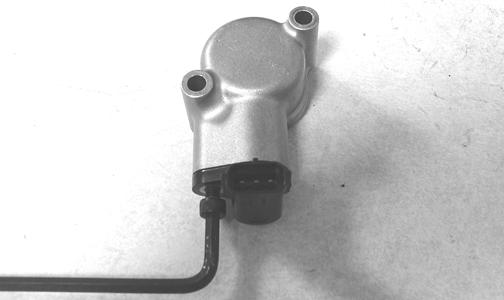
CD070
3.Install the new speed sensor into the housing with new
O-ring lightly coated with multi-purpose grease; then secure the sensor with the Allen-head cap screw (threads coated with blue Loctite #242). Tighten securely.
CD071
Electronic Power Steering (EPS)
The EPS system is an electro-mechanical device that utilizes 12 volt DC power to drive a motor linked to the steering shaft to assist the driver when rotating the steering wheel. Driver steering inputs are detected by a torque-sensing transducer assembly within the EPS housing. These inputs are converted to electronic signals by the transducer and control circuitry to tell the motor which way to drive the steering shaft. When no steering input (pressure on the steering wheel) is detected, no torque signal is generated, and no steering assist is provided by the motor.
The EPS system is battery-system powered; therefore, the battery must be in good condition and fully charged. Power delivery and overload protection are provided by an EPS relay and 30-amp fuse, located under the seat in the Power Distribution Module (PDM). If a system malfunction occurs, a diagnostic trouble code (DTC) will be displayed on the LCD gauge. Initially, the gauge will go blank for 30 seconds and the code will flash; then the gauge will return to normal except the code will continue to be displayed. The following is a list of conditions that can generate a code. NOTE: The EPS assembly is not serviceable and
must not be disassembled or EPS warranty will be voided. Make sure to thoroughly troubleshoot the entire system before replacing the EPS assembly.
Code Fault Description Possible Cause Recovery Method
C1301Over Current Internal EPS Condition Correct EPS condition, then cycle key switch On-Off-On
C1302Excessive Current Error Internal EPS Condition Correct EPS condition, then cycle key switch On-Off-On
C1303Torque Sensor Range Fault Internal EPS Condition Correct EPS condition, then cycle key switch On-Off-On
C1304Torque Sensor Linearity Fault Internal EPS Condition Correct EPS condition, then cycle key switch On-Off-On
C1305Rotor Position Encoder Internal EPS Condition Correct EPS condition, then cycle key switch On-Off-On
C1306System Voltage Low
C1307System Voltage High System voltage low (less than 11 V DC at EPS). Wire harness issue, faulty voltage regulator, weak battery, or loose battery terminals. EPS will auto-recover when battery supply returns to normal
System voltage is high (more than 16 V DC at EPS). Wire harness issue, faulty voltage regulator, or loose battery terminals. EPS will auto-recover when the battery supply returns to normal
C1308Temp Above 110° C
C1309Temp Above 120° C Clean EPS housing and cooling fins. EPS will auto-recover when internal temp drops below 150° C
Clean EPS housing and cooling fins. EPS will auto-recover when internal temp drops below 115° C
C1312Vehicle SpeedBroken CAN wires in main harness, disconnected or defective speed-sensor, broken speed sensor wires. C1315Engine RPM Broken CAN wires in the main harness. EPS will auto-recover when vehicle speed signal returns to normal EPS will auto-recover when engine RPM signal returns to normal
C1316EEPROM Error Internal EPS condition Correct EPS condition, then cycle key switch On-Off-On
C1317CAN Bus Error Broken CAN wires in main harness. EFI ECM connector has been disconnected. Correct EPS condition, then cycle key switch On-Off-On
C1318CRC Error EPS reflash failed. Battery power lost or key switch turned off during EPS reflash. EPS must be reprogrammed
C1319Boot Counter Exceeded EPS reflash failed. Battery power lost or key switch turned off during EPS reflash. EPS must be reprogrammed
C1323“EPS OFF” Gauge Display EPS automatically disabled after five minutes of inactivity to conserve battery power. EPS will auto-recover when engine is started or key switch is cycled On-Off-On
C1324Loss of CAN communication with EPS unit Broken CAN wires in main harness or disconnected EPS. Not EPS generated DTC; gauge DTC display only. Gauge DTC display will clear when EPSto-gauge CAN communication restored. The following tests may help in determining the source of a code: Condition: Ignition Key Switch ON and NO EPS assist when moving the steering wheel. Code flashing. NOTE: Prior to troubleshooting below, make sure
the Ignition Key Switch has not been left on with the engine not started. After five minutes, this will deactivate the EPS and display the code. Turn the Ignition Key Switch OFF and back to ON to reset and reactivate the EPS. If code and symptom persists, continue as follows:
1.Check 30-amp EPS fuse. 2.Check EPS relay (may be switched with any other 4pin relay on PDM - replace relay if EPS normal after switching). 3.Disconnect 2-pin connector on the EPS assembly and connect a volt meter set to DC voltage to the harness (black meter lead to BLK and red meter lead to ORG/
BRN).With the ignition switch to the ON position, the meter must read more than 8.5 DC volts (if correct voltage is not present, check connections and wiring harness - if correct voltage is present, replace EPS assembly - see Steering/Frame/Controls).
If after completing the above checks with normal results and a code persists, the EPS assembly must be replaced (see Steering/Frame/Controls).
CAUTION
Do not attempt to check resistance of the EPS motor (2-pin input receptacle). There are internal capacitors holding a charge that can cause internal damage to an ohmmeter.
Ignition Switch
To access the ignition switch, dash switches, front accessory connectors, and front switched accessory connector, the dash must be unfastened and slid to the rear. VOLTAGE 1.Set the meter selector to the DC Voltage position. 2.Connect the red meter lead to the red wire; then connect the black meter lead to ground. 3.Meter must show battery voltage. NOTE: If the meter shows no battery voltage, trou-
bleshoot the main 30 amp fuse, the battery, or the main wiring harness.
4.Connect the red meter lead to the brown/black wire; then with the black lead grounded, turn the ignition switch to the ON position. The meter must show battery voltage. 5.Connect the red meter lead to the yellow/green wire; then with the black lead grounded, turn the ignition switch to the START position. The starter should engage and the meter must show battery voltage. NOTE: When the starter is engaged, battery voltage
will be approximately 10.5 DC volts.
Headlight Switch
VOLTAGE 1.Connect the red meter lead to the gray wire; then connect the black meter lead to the black wire. 2.Turn the ignition switch to the ON position. The meter must show battery voltage. NOTE: If the meter does not show battery voltage,
troubleshoot the LIGHTS fuse on the power distribution module, the ignition switch, or the main harness.
3.Connect the red meter lead to the yellow wire; then select the high beam position on the headlight switch.
The meter must show battery voltage. 4.Connect the red meter lead to either of the two gray wires; then select the low beam position on the headlight switch. The meter must show battery voltage. NOTE: The battery voltage will show lower in steps
3 and 4 due to electrical loading of the headlights.
Drive Select Switch
RESISTANCE 1.Remove the switch assembly from the dash; then disconnect the harness from the switch. NOTE: The switch can be removed from the dash
using a thin, flat pry bar or suitable putty knife. It is not necessary to remove the dash to remove the switch.
2.Using an ohmmeter, the following readings must be observed.
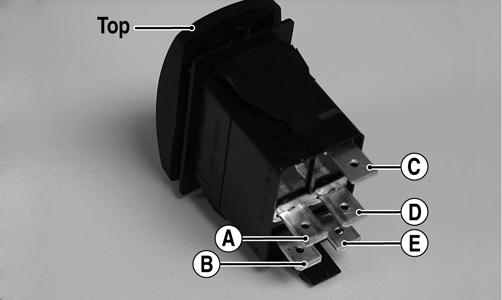
PR566A WIRE COLOR 2WD 4WD DIFFERENTIAL LOCK
Black to Orange12.0 DC Volts12.0 DC Volts 12.0 DC Volts Black to White/ 11.5 DC Volts 0 DC Volts 0 DC Volts
Green Black to White/ 11.5 DC Volts11.5 DC Volts 0 DC Volts
Orange
2WD 4WD DIFFERENTIAL LOCK
A to D <1 ohm A to D <1 ohm A to D <1 ohm C to E <1 ohm C to E <1 ohm C to E <1 ohm A to B Open A to B <1 ohm A to B <1 ohm A to C Open A to C Open A to C <1 ohm A to E Open A to B <1 ohm A to C <1 ohm VOLTAGE NOTE: Voltage tests must be made with the switch
and the actuator connected. The meter can be connected at the actuator connector using a break-out harness or MaxiClips.
1.Connect the black tester lead to the black wire; then turn the ignition switch to the ON position. 2.Select the DC Volts position on the tester and observe the meter readings for each of the three switch positions.
NOTE: If the meter does not show voltages accord-
ing to the chart, make sure the front drive actuator is plugged in; then troubleshoot the switch, ignition fuses, battery connections, or wiring harness.
Reverse Override Switch
VOLTAGE NOTE: To perform the following tests, the ignition
switch must be in the ON position and the transmission shifted into reverse gear.
1.Connect the red meter lead to the black/green wire and the black meter lead to a suitable ground; then select 2WD on the drive select switch. The meter must show approximately 1.5 DC volts. 2.Depress the reverse override switch. The meter showing should not change from step 1. 3.Select 4WD on the drive select switch. The meter must show approximately 5 DC volts. 4.Depress the reverse override switch. The meter must show approximately 1.5 DC volts.
Front Drive Actuator
NOTE: With the engine stopped and the ignition
switch in the ON position, a momentary “whirring” sound must be noticeable each time the drive select switch is moved to 2WD and 4WD. Test the switch, 30 amp fuse, and wiring connections prior to testing the actuator.
NOTE: The differential must be in the unlocked
position for this procedure.
VOLTAGE 1.Locate the 4-wire connector for the front drive actuator on the frame to the right of the differential; then connect the red meter lead to the orange wire using a
MaxiClip.
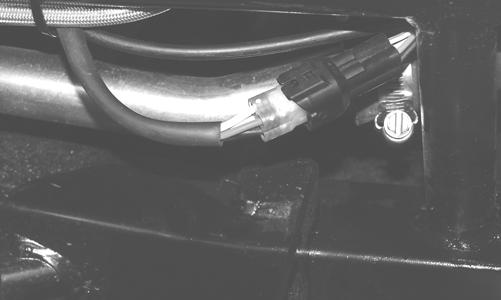
PR293
2. Connect the black lead to the black wire using a MaxiClip; then select 2WD on the drive select switch.
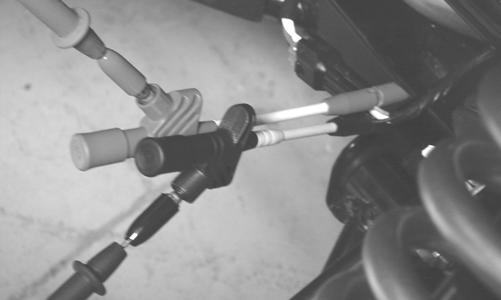
PR295
NOTE: The black tester lead can remain connected
to the black wire for the remaining tests.
3.Turn the ignition switch to the ON position. The meter must show battery voltage. NOTE: If battery voltage is not shown, troubleshoot
the 10 amp ignition (IGN) fuse on the power distribution module, the ignition switch, or the main wiring harness.
4.Connect the red meter lead to the white/green wire.
The meter must show battery voltage. 5.Select 4WD on the drive select switch. The meter must show 0 DC volts. 6.Connect the red meter lead to the white/orange wire.
The meter must show battery voltage. 7.Engage the differential lock. The meter must show 0
DC volts. NOTE: If the meter does not show 0 DC volts, rock
the vehicle to help engage the differential lock; then troubleshoot the differential lock switch (see Drive Select Switch in this section).
Stator Coil/Crankshaft Position (CKP) Sensor
NOTE: Preliminary checks may be performed on this
component using the diagnostic mode on the LCD gauge (see EFI Diagnostic System in this section).
VOLTAGE (AC Generator - Regulated Output) 1.Set the meter selector to the DC Voltage position. 2.Connect the red tester lead to the positive battery post; then connect the black tester lead to the negative battery post. 3.With the engine running at a constant 5000 RPM (with the headlights on), the meter must show 14-15.5 DC volts.
CAUTION
Do not run the engine at high RPM for more than 10 seconds.
NOTE: If voltage is lower than specified, test AC
Generator - No Load.
VOLTAGE (AC Generator - No Load) The connector is the black three-pin one on the left side below the shift arm.
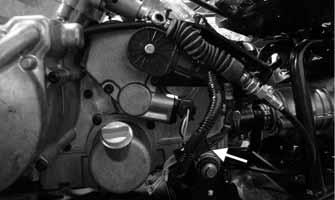
WC177B
NOTE: Test the connector coming from the engine.
1.Set the meter selector to the AC Voltage position. 2.Test between the three yellow wires for a total of three tests. 3.With the engine running at a constant 5000 RPM, all wire tests must be within specification.
CAUTION
Do not run the engine at high RPM for more than 10 seconds.
NOTE: If any stator coil test failed, replace the sta-
tor assembly.
RESISTANCE (AC Generator) 1.Set the meter selector to OHMS position.
2.Test between the three black wires for a total of three tests. 3.The meter reading must be within specification. RESISTANCE (Crankshaft Position Sensor) 1.Set the meter selector to the OHMS position. 2.Connect the red tester lead to the brown/white wire; then connect the black tester lead to the green/white wire. The meter reading must be within specification. AC VOLTAGE NOTE: The battery must be at full charge for these
tests.
Crankshaft Position Sensor 1.Set the meter selector to the AC Voltage position. 2.Connect the red tester lead to the brown/white wire; then connect the black tester lead to the green/white wire. 3.Crank the engine over using the electric starter. 4.The meter reading must be within specification.
Starter Motor
NOTE: Preliminary checks may be performed on this
component using the diagnostic mode on the LCD gauge (see EFI Diagnostic System in this section).
NOTE: The starter motor is not a serviceable component. If the motor is defective, it must be replaced.
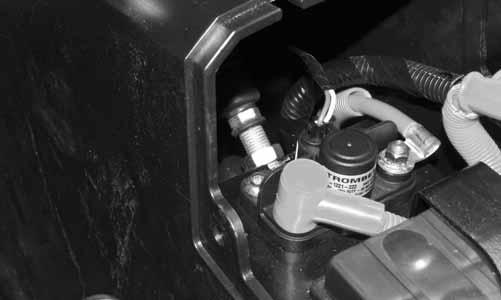
REMOVING 1.Disconnect the battery.
CAUTION
Always disconnect the negative battery cable from the battery first; then disconnect the positive cable.
2.Remove the nut securing the positive cable to the starter motor; then remove the cable from the starter. 3.Remove the two cap screws securing the starter motor with ground wires to the crankcase; then remove the starter motor. Account for the wiring forms and an Oring. INSTALLING 1.Apply a small amount of grease to the O-ring seal on the starter motor; then install the starter into the crankcase.
Secure with two machine screws and wiring forms. 2.Secure the positive cable to the starter motor with the nut. 3.Connect the battery. TESTING VOLTAGE Perform this test on the starter motor positive terminal. To access the terminal, slide the boot away. 1.Set the meter selector to the DC Voltage position. 2.Connect the red tester lead to the starter terminal; then connect the black tester lead to ground.
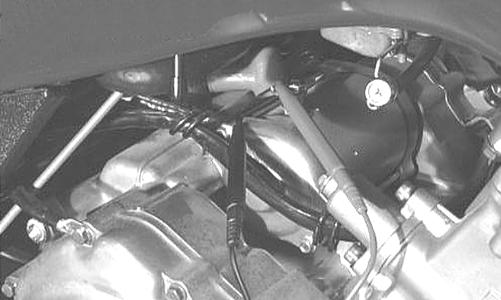
AR607D
3.With the starter button depressed, the meter must show battery voltage and the starter motor should operate. NOTE: If the meter showed battery voltage but the
starter motor did not operate or operated slowly, inspect battery voltage (at the battery), starter motor condition, and/or ground connections.
NOTE: If the meter showed no battery voltage,
inspect the main fuse, ground connections, starter motor lead, battery voltage (at the battery), starter relay, or the neutral start relay.
Starter Relay
1.Remove the battery cover; then using the multimeter set to the DC Voltage position, check the relay as follows. 2.Connect the red tester lead to the positive battery cable; then connect the black tester lead to the starter cable connection on the starter relay. The meter must show battery voltage.
Black Tester Lead
Red Tester Lead
WC031A
NOTE: Make sure the ignition switch is in the ON posi-
tion and the transmission is in park.
3.Depress the starter button while observing the multimeter. The multimeter should drop to 0 volts and the stater should engage. NOTE: If the starter engages and more than one volt
is indicated by the multimeter, replace the starter relay. If no “click” is heard and the multimeter continues to indicate battery voltage, proceed to step 4.
4.Disconnect the two-wire plug from the starter relay; then connect the red tester lead to the green wire and the black tester lead to the black wire.
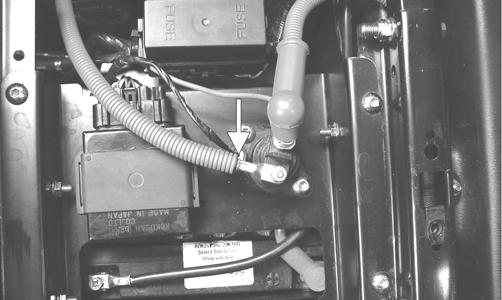
PR297A
5.Depress the starter button and observe the multimeter. NOTE: If battery voltage is indicated, replace the
starter relay. If no voltage is indicated, proceed to Power Distribution Module (PDM) check.
Engine Control Module (ECM)
The ECM is located beneath the passenger seat. NOTE: The ECM is not a serviceable component. If
the unit is defective, it must be replaced.
The ECM is rarely the cause of electrical problems; however, if the ECM is suspected, substitute another modelcompatible ECM to verify the suspected one is defective. This EFI system has a built-in feature that will only allow an ECM of the same part number to be used in these models. Do not attempt to substitute an ECM from a different model as the system will not allow it to start. Error codes can be cleared by following the procedures located in the EFI Diagnostic System sub-section in this section.
Regulator/Rectifier
NOTE: Preliminary checks may be performed on
this component using the diagnostic mode on the LCD gauge (see EFI Diagnostic System in this section).
The regulator/rectifier is located under the hood above the differential. Verify all other charging system components before the regulator/rectifier is replaced. TESTING 1.Start engine and warm up to normal operating temperature; then connect a multimeter (set at the DC Voltage position) to the battery as follows. 2.Connect the red tester lead to the positive battery post and the black tester lead to the negative battery post. 3.Slowly increase RPM. The voltage should increase with the engine RPM to a maximum of 15.5 DC volts. NOTE: If voltage rises above 15.5 DC volts, the reg-
ulator is faulty or a battery connection is loose or corroded. Clean and tighten battery connections or replace the regulator/rectifier. If voltage does not rise, see Stator Coil/Crankshaft Position (CKP) Sensor Voltage in this section. If charging coil voltage is normal, replace the regulator/rectifier.
Headlights
The connectors are the two 3-prong ones secured to the headlight assemblies (one on each side). VOLTAGE 1.Set the meter selector to the DC Voltage position. 2.Set the light switch to the correct position for the affected light; then connect the black tester lead to the black wire using a MaxiClip. 3.Connect the red tester lead to the yellow/black wire (high beam) or white wire (low beam) using a Maxi-
Clip. The meter must show battery voltage. NOTE: If battery voltage is not shown in any test,
inspect the LIGHTS fuse on the power distribution module, headlight switch, ignition switch, switch connectors, or wiring harness.
Taillight-Brakelight
VOLTAGE (Taillight) NOTE: Perform this test at the socket end of the tail-
light-brakelight harness (pigtail). The ignition switch must be in the ON position and either high beam or low beam selected on the light switch.
1.Set the meter selector to the DC Voltage position. 2.Connect the black tester lead to the black wire; then connect the red tester lead to the white wire. 3.With the ignition key ON and the switch in the HI or
LOW position, the meter must show battery voltage.
NOTE: If battery voltage is not shown and the head-
lights are illuminated, inspect the three-wire connector in the left-rear canopy tube at the juncture of the canopy tube and lower frame. If battery voltage is shown on the meter, replace the LED.
VOLTAGE (Brakelight) NOTE: Perform this test at the socket end of the tail-
light/brakelight harness (pigtail). The ignition switch must be in the ON position.
1.Set the meter selector to the DC Voltage position. 2.Connect the red tester lead to the red/blue wire; then connect the black tester lead to the black wire. 3.With the brake applied, the meter must show battery voltage. NOTE: If the meter shows no voltage, inspect the 10
amp ignition (IGN) fuse, brakelight switch, wiring harness, or connectors.
Ignition Timing
The ignition timing cannot be adjusted; however, verifying ignition timing can aid in troubleshooting other components. To verify ignition timing, use the following procedure. NOTE: To check ignition timing, the seats and cen-
ter console must be removed.
1.Attach the Timing Light to the spark plug high tension lead; then remove the timing inspection plug from the left-side crankcase cover. 2.Start the engine and using the RPM function on the speedometer/tachometer, run at 1500 RPM; ignition timing should be 10° BTDC. 3.Install the timing inspection plug. If ignition timing cannot be verified, the rotor may be damaged, the key may be sheared, the trigger coil bracket may be bent or damaged, or the ECM may be faulty.
Tilt Sensor
The tilt sensor is located in the center console above the forward driveline coupler. The seats and center console must be removed to access the sensor. SUPPLY VOLTAGE 1.Disconnect the three-wire connector from the sensor; then select DC Voltage on the multimeter and connect the red tester lead to the orange wire (C) and the pink tester lead to the pink wire (A).
! WARNING
Incorrect installation of the tilt sensor could cause sudden loss of engine power which could result in loss of vehicle control resulting in injury or death.
CAUTION
Do not drop the tilt sensor as shock can damage the internal mechanism.
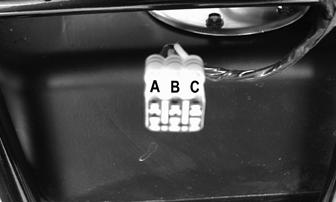
CD706C
2.Turn the ignition switch to the ON position. The multimeter should read battery voltage. If battery voltage is not indicated, check the 30-amp fuse, wiring harness, or the ignition switch. 3.Remove the red tester lead and connect to the blue/ brown wire (B). The multimeter should read approximately 2.5 DC volts. If the specified voltage is not indicated, check wire connections at the ECM or substitute another ECM to verify the test. OUTPUT VOLTAGE NOTE: Needle adapters will be required on the mul-
timeter leads as the following tests are made with the sensor connected.
1.Connect the three-wire plug to the sensor; then remove the right-side mounting screw securing the sensor to the frame. 2.Install the needle adapters to the multimeter leads; then select DC Voltage on the multimeter. 3.Connect the red tester lead to the blue/brown wire (B) and the black tester lead to the pink/black wire (A); then turn the ignition switch ON and observe the meter. The meter should read 0.8-3.0 DC volts.
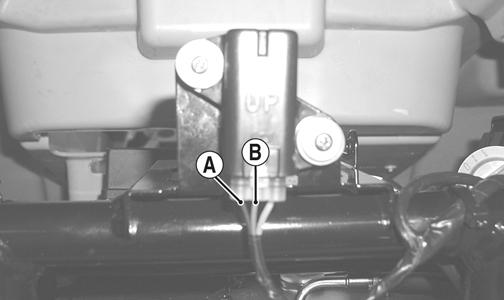
CD705B
4.Tilt the sensor 60° or more to the left and right observing the meter. The meter should read 4.0-8.0 DC volts after approximately one second in the tilted position.
If the meter readings are not as specified, the tilt sensor is defective.
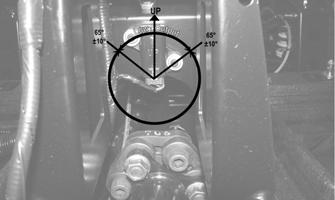
WC159A
Throttle Position Sensor (TPS)
NOTE: Preliminary checks may be performed on
this component using the diagnostic mode on the LCD gauge (see EFI Diagnostic System in this section).
INSPECTING
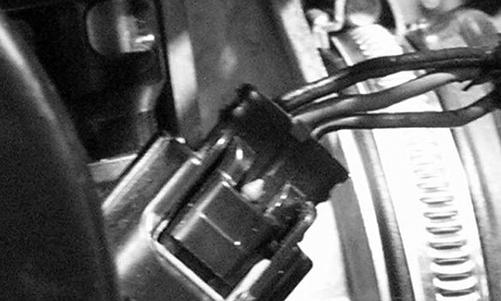
PR544
1. Remove the seats and rear body panel; then remove the two top radiator mounting cap screws and tilt the radiator rearward to access the throttle body. Remove the
TPS connector plug from the TPS. NOTE: Prior to testing the TPS, inspect the three-
wire plug connector on the main harness and the three-pin plug on the TPS for contamination, broken pins, and/or corrosion.
2.Make sure the ignition switch is in the OFF position; then select the DC Voltage position on the meter. 3.Connect the red tester lead to terminal B and the black tester lead to terminal A. Turn the ignition switch to the ON position. The meter should read approximately 5.0 DC volts.
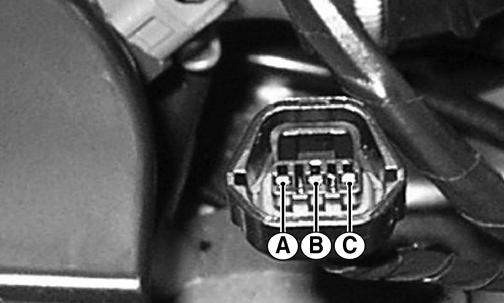
PR538A
NOTE: If the meter does not read as specified,
check for poor connections at the ECM or open/broken wires in the wiring harness.
CAUTION
Always make sure the ignition switch is in the OFF position before disconnecting the ECM.
4.Turn the ignition switch to the OFF position. 5.Select the OHMS position on the meter; then perform the following resistance tests on the TPS.
A.Pin (B) to ground - infinity (open circuit).
B.Pin (A) to pin (C) - approximately 1k ohms (throttle closed).
C.Pin (A) to pin (C) - approximately 5k ohms (throttle full-open).
D.Pin (A) to pin (B) - approximately 5k ohms.
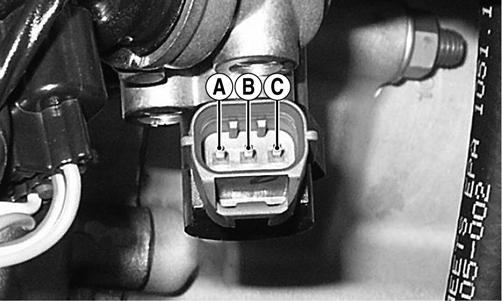
PR535A
NOTE: If any meter reading is not as specified,
replace or adjust the TPS (see INSTALLING/ADJUSTING in this sub-section).
6.Connect the positive lead to the battery; then connect the negative lead. 7.Connect the main harness TPS connector to the TPS; then using MaxiClips, connect the black tester lead to the black/green wire and the red tester lead to the green/black wire.
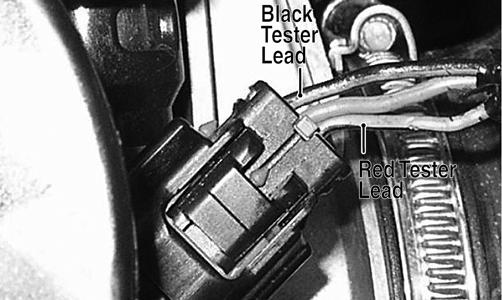
PR546A
8.Select the DC Voltage position on the meter and turn the ignition switch to the ON position. The meter should read approximately 0.6 DC volt with the throttle closed and approximately 4.0 DC volts with the throttle in the full-open position. NOTE: If the meter readings are as specified, check
the main harness connector at the ECM main harness wiring. If the meter readings are not as specified, replace the TPS and adjust to specifications (see INSTALLING/ADJUSTING in this sub-section).
CAUTION
Always make sure the ignition switch is in the OFF position before disconnecting the ECM.
9.Verify all codes are cleared after servicing is complete (see EFI Diagnostic System in this section). REMOVING
1. Remove the seats and rear body panel; then remove the two top radiator mounting cap screws and tilt the radiator rearward to access the throttle body. Remove the
TPS connector plug from the TPS. 2.Remove the screw securing the TPS to the throttle body and remove the TPS. INSTALLING/ADJUSTING 1.Place the TPS into position on the throttle body and secure with the screw. Do not tighten at this time. 2.Connect the TPS Multi-Analyzer Harness connector #8 to the TPS; then connect the harness to the TPS
Analyzer Tool.
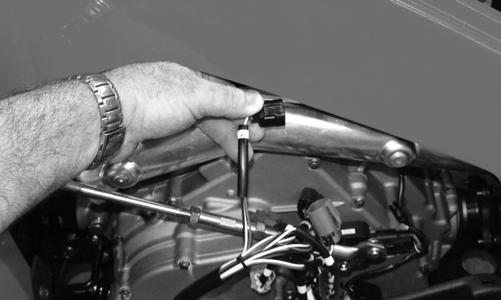
FI672
3.Using a multimeter, connect the black tester lead to the white socket (VAR) on the analyzer and the red tester lead to the red socket (+SV); then select the DC
Voltage position.
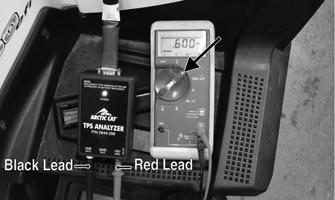
FI676A
4.Adjust the TPS until a reading of 0.6 DC volt is obtained; then tighten the screw securely. Open and close the throttle and determine the reading returns to 0.6 DC volt. Adjust as necessary. 5.Disconnect the harness from the analyzer; then disconnect the harness from the TPS and reconnect the
TPS main harness connector.
EFI Diagnostic System
DIGITAL GAUGE The digital gauge can be used as a diagnostic tool for many of the DTC’s displayed. To place the gauge into the diagnostic mode, use the following procedure. 1.Turn the ignition switch ON. 2.Depress and hold both Mode and Set buttons together for approximately 10 seconds after which the letters “dIAg” will appear on the LCD momentarily followed by COOL.
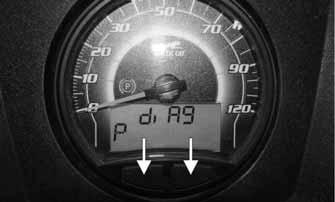
EFI033A
NOTE: The display on the gauge will display in SAE (speedometer in MPH mode) or Metric (speedometer in km/h mode), For example to read temperature in degrees Celsius, select km/h mode on the gauge or to read Fahrenheit, select MPH mode.
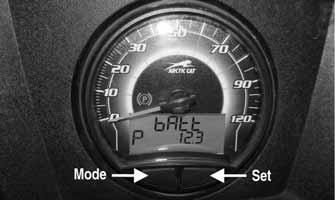
EFI025A
NOTE: The gauge can be utilized dynamically
(engine running/vehicle moving) or statically (engine/vehicle stopped).
Examples of Static checks: Battery voltage, fuel gauge/ sensor, and TPS (0% @ closed throttle, 95-100% @ WOT).
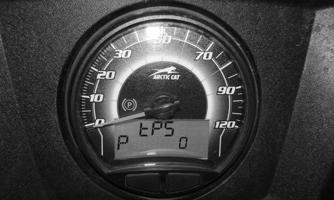
EFI028
Examples of Dynamic checks: Battery charging, coolant temperature including fans ON/OFF (see below), MAP/ IAT, tachometer, and speedometer signal.
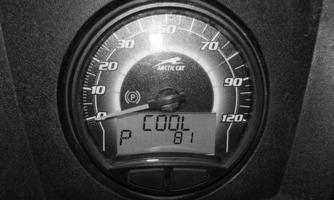
EFI032
*Fan Schedule: Left fan ON @ 185 degrees F, OFF @ 175 degrees F; Right fan ON @ 195 degrees F, OFF @ 185 degrees F. *High Temperature REV Limiter 5000 RPM @ 230 degrees F. *Thermostat opens @ approximately 180 degrees F noted by a 2-5 degree drop momentarily. EFI032
Display: Engine coolant temperature as measured by the ECT sensor.
DTC: P0116, P0117, P0118, P0119 Usage: Monitor coolant temperature to verify the following. 1.ECT sensor signal 2.High Temperature indicator (on @ 230 degrees F.) 3.Thermostat opening @ approximately 180 degrees F, indicated by a momentary drop or pause in the rising temperature reading. 4.Left fan ON @ 185° F, OFF @ 175° F; right fan ON @ 195° F, OFF @ 185° F.
A.fan motor
B.fan relay
C.fan fuse
D.wiring connections 5.High Temperature Rev Limiter 5000 RPM @ 230 degrees F. Fuel Sensor (FUEL) Diagnostic Mode
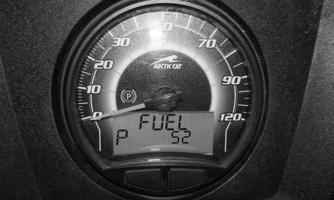
EFI031
Display: Fuel level signal from the fuel level sensor (measured in ohms). DTC: C1400, C1401, C1402 Usage: Check output of the fuel level sensor 1.Full fuel is indicated by a reading of 86-100 ohms 2. Empty is indicated by a reading of 0-5 ohms.
* 110-500 ohms, suspect the fuel level sensor or wiring * 0-100 ohms but no fuel gauge indication, suspect the fuel gauge
Tachometer (tACH) Diagnostic Mode
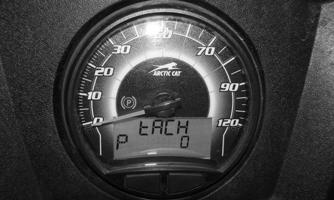
EFI030
Display: Engine RPM DTC: P0336, P0337, P0339 Usage: Verify engine speed signal from the following. 1.CKP (crankshaft position) sensor to ECM 2. ECM (CAN) signal to gauge (tachometer) 3. ECM (CAN) signal to EPS Speed (SPd) Diagnostic Mode
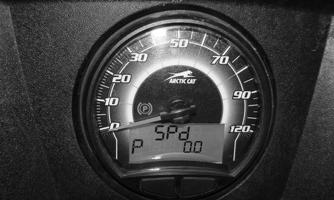
EFI029
Display: vehicle speed signal. DTC: P0500
Usage: verify speedometer sensor signal from the following. 1.Speed sensor to ECM. 2.ECM (CAN) signal to gauge (speedometer/odometer). 3.ECM (CAN) signal to EPS unit.

EFI028
Display:% of TPS (0% closed, 95-100% WOT). DTC: P0121, P0122, P0123 Usage: Verify TPS signal and adjust throttle cable. MAP (bArO) Diagnostic Mode
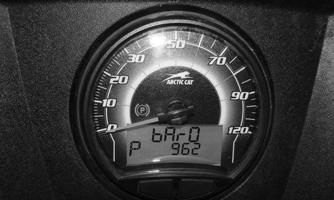
EFI027
Display: MAP in millibars (1013 millibar = 29.92 in. mercury). DTC: P0107, P0108 Usage: Verify barometric pressure signal correct. Note: Local barometric pressure is given in in./
Hg (Inches of Mercury). 34 millibars are equal to 1 inch of mercury. Example: (Gauge reading in the BARO mode = 974 millibars, thus 974/34 = 28.64 in./Hg). Second example: (Local barometer reading is 29.87 in./Hg, therefore 29.87 X 34 = 1015 millibars) The gauge should be reading very close to 1015.
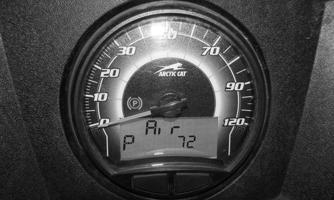
EFI026
Display: Inlet air temperature in Fahrenheit or Celsius. DTC: P0112, P0113, P0114 Usage: Verify correct output of IAT sensor. NOTE: After engine has been running, IAT read-
ings will be higher than outside air temperature due to engine and engine compartment heat as well as intake manifold heating.
Battery (bAtt) Diagnostic Mode
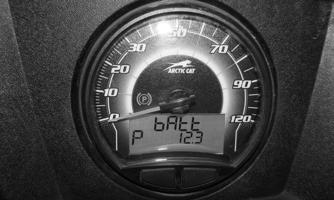
EFI025
Display: System DC voltage. DTC: P0562, P0563, P2531, P2532 Usage: Verify system voltage under following conditions.
1.Battery voltage with engine and accessories off (>12.2 VDC for fully charged). 2.Battery voltage with engine running (charging = 13.8
VDC or greater). 3.Battery voltage with electrical accessories operating, engine idling (13.5 VDC or greater). 4.Battery voltage starter cranking (10.5-11.5 VDC). DIAGNOSTIC TROUBLE CODES (DTC) If an EFI or related chassis component fails or an out-oftolerance signal is detected by the ECM, a diagnostic trouble code (DTC) will be generated in the ECM and displayed on the LCD. The DTC will be displayed alternately with a wrench icon or malfunction indicator light (MIL). The DTC will continue to flash, until the malfunction is corrected and the code cleared. Code List NOTE: Each of the following numerical codes will
have a one-letter prefix of C, P, or U. A “C” prefix denotes a chassis malfunction, a “P” prefix denotes a power train malfunction, and a “U” prefix denotes a loss of communication with the gauge.
NOTE: Normal malfunction codes are cleared from
the LCD when the component is replaced or the malfunction is corrected; however, intermittent codes must be cleared as noted in the code chart.
Gauge DTC Wrench Icon Status ECM PIN Description
C0063(1) D2 Tilt Sensor Circuit High
C0064(1) ON D2 Tilt Sensor Circuit Low/SG/Open
C1400 OFF 17 (Gauge) Fuel Sender Open
C1401 OFF 17 (Gauge) Fuel Sender High/SP
C1402 OFF 17 (Gauge) Fuel Sender Low/SG
P0107 ON F2 MAP Sensor Circuit Low/SG/Open
P0108 ON F2 MAP Sensor Circuit High/SP
P0112 ON F3 Intake Air Temp Sensor Circuit Low/SG
P0113 ON F3 Intake Air Temp Sensor Circuit High/Open
P0114(1) OFF F3 Intake Air Temp Sensor Circuit Intermittent
P0116 ON F4 Engine Coolant Temp Sensor Circuit Range/Performance
P0117 ON F4 Engine Coolant Temp Sensor Circuit Low/SG
P0118 ON F4 Engine Coolant Temp Sensor Circuit High/Open/SP
P0119(1) OFF F4 Engine Coolant Temp Sensor Circuit Intermittent
P0121 G3 Throttle Position Sensor Range/Performance
P0122 ON G3 Throttle Position Sensor Circuit Low/SG
P0123 ON G3 Throttle Position Sensor Circuit High
P0219 N/A Engine Over-Speed Condition
P0231 ON J1 Fuel Pump Relay Circuit Low/SG/Open
P0232 J1 Fuel Pump Relay Circuit High
P0233(1) J1 Fuel Pump Relay Circuit
P0261(2) ON L4 Rear Cylinder Injector Circuit Low/SG
P0262(2) ON L4 Rear Cylinder Injector Circuit High
P0263(2) ON L4 Rear Cylinder Injector Balance/Open
P0264(2) ON K4 Front Cylinder Injector Circuit Low/SG
P0265(2) ON K4 Front Cylinder Injector Circuit High
P0266(2) ON K4 Front Cylinder Injector Balance/Open
P0336(1) ON D1/E1 Crankshaft Angle Sensor Synchronization
P0337(1) ON D1/E1 Crankshaft Angle Sensor Circuit/SG
P0339(1) ON D1/E1 Crankshaft Angle Sensor Intermittent/Erratic
P0480 K2 Fan Relay Control Circuit
P0484 K2 Fan Relay Control Circuit High
P0485 ON K2 Fan Relay Control Circuit Low/SG/Open
P0500 Gauge Direct Error-Code N/A Vehicle Speed-Sensor
P0508 ON C4/D3/D4/E4 Idle Air Control System Circuit Low/SG
P0509 ON C4/D4 Idle Air Control System Circuit High/Open
P0562 L1 System Voltage Low
P0563 L1 System Voltage High
P0601 N/A ECM Memory Check-Sum Error
P0615(1) L3 Starter Relay Circuit
P0616 ON L3 Starter Relay Circuit Low
P0617 L3 Starter Relay Circuit High
P0630 ON N/A VIN Not Programmed or Incompatible
P0635 Gauge Direct Error-Code N/A Power-Steering Controller Circuit
P0642 A1 Sensor Power Circuit Low
P0643 ON A1 Sensor Power Circuit High
P0856 Gauge Direct Error-Code N/A Traction Controller Circuit
P2300(2) ON M1 Rear Ignition Coil Primary Circuit Low/SG/Open
P2301(2) ON M1 Rear Ignition Coil Primary Circuit High
P2303(2) ON M2 Front Ignition Coil Primary Circuit Low/Open
P2304(2) ON M2 Front Ignition Coil Primary Circuit High
P2531 A4 Ignition Switch Circuit Low
P2532 A4 Ignition Switch Circuit High
U0155 B1/C1 LCD Gauge Communication Lost
“FUEL OFF” Gauge Direct Error-Code Tilt Sensor Activation Operator-Code High = Signal Level is too High (Possible Short-to-Battery (+)) Low = Signal Level is too Low (Possible Short-to-Ground or Short-to-Chassis) SG = Possible Short-to-Ground or Short-to-Chassis SP = Possible Short-to-Power or Short-to-Battery Open = Open-Circuit (Possible Broken-Wire or No-Connection) (1): These codes cleared by one complete power-cycle only (key-off, power-latch, key-on): C0063, C0064, P0114, P0119, P0233, P0336, P0337, P0339, P0615 (2): These codes cleared by one complete starting-cycle only (key-off, power-latch, key-on, start, key-off, power-latch, key-on): C0261, P0262, P0263, P0264, P0265, P0266, P2300, P2301, P2303, P2304
Troubleshooting
Problem: Spark absent or weak Condition Remedy
1. Ignition coil defective 1.Replace ignition coil 2. Spark plug(s) defective 2.Replace plug(s) 3. CKP sensor defective 3.Replace CKP sensor 4. ECM defective 4.Replace ECM
Problem: Spark plug fouled with carbon Condition Remedy
1. Gasoline incorrect 1.Change to correct gasoline 2. Air cleaner element dirty 2.Clean element 3. Spark plug(s) incorrect (too cold) 3.Replace plug(s) 4. Valve seals cracked - missing 4.Replace seals 5. Oil rings worn - broken 5.Replace rings
Problem: Spark plug electrodes overheat or burn Condition Remedy
1. Spark plug(s) incorrect (too hot) 1.Replace plug(s) 2. Engine overheats 2.Service cooling system 3. Spark plug(s) loose 3.Tighten plug(s)
Problem: Battery does not charge Condition Remedy
1. Lead wires/connections shorted - loose - open 1.Repair - replace - tighten lead wires 2. Stator coils shorted - grounded - open 2.Replace stator coils 3. Regulator/rectifier shorted 3.Replace regulator/rectifier
Problem: Battery charges, but charging rate is below the specification Condition Remedy
1. Lead wires shorted - open - loose (at terminals) 1.Repair - tighten lead wires 2. Stator coils grounded - open 2.Replace stator coils 3. Regulator/rectifier defective 3.Replace regulator/rectifier 4. Cell plates (battery) defective 4.Replace battery
Problem: Magneto overcharges Condition Remedy
1. Battery short circuited 1.Replace battery 2. Regulator/rectifier defective 2.Replace regulator/rectifier 3. Regulator/rectifier poorly grounded 3.Clean - tighten ground connection
Problem: Charging unstable Condition Remedy
1. Lead wire intermittently shorting 1.Replace lead wire 2. Magneto internally shorted 2.Replace stator coil 3. Regulator/rectifier defective 3.Replace regulator/rectifier
Problem: Starter does not engage Condition Remedy
1. Battery charge low 1.Recharge - replace battery 2. Switch contacts defective 2.Replace switch 3. Starter motor brushes not seating 3.Replace starter 4. Starter relay defective 4.Replace relay 5. Wiring connections loose - disconnected 5.Connect - tighten - repair connections 6. Start-in-gear/neutral relay defective 6.Replace relay
Problem: Battery “sulfation” (Acidic white powdery substance or spots on surfaces of cell plates) Condition Remedy
1. Charging rate too low - too high 1.Replace battery 2. Battery discharged 2.Charge battery
Problem: Battery discharges too rapidly Condition Remedy
1. Charging system (charging operation) not set properly 1.Check AC generator - regulator/rectifier - circuit connections 2. Cell plates overcharged - damaged 2.Replace battery - correct charging system 3. Battery short-circuited 3.Replace battery 4. Electrical load too high 4.Reduce load
Problem: Battery polarity reversed Condition Remedy
1. Battery incorrectly connected 1.Reverse connections - replace battery

